Comprehensive Analysis of Cargo Management and Ship Survey
VerifiedAdded on 2022/08/23
|12
|2817
|30
Report
AI Summary
This report provides a detailed analysis of cargo management and ship surveys, focusing on key aspects such as the MARPOL convention, Bunker surveys, and the STCW convention. The report begins with an introduction to cargo management's role in maritime trade and then delves into the MARPO...
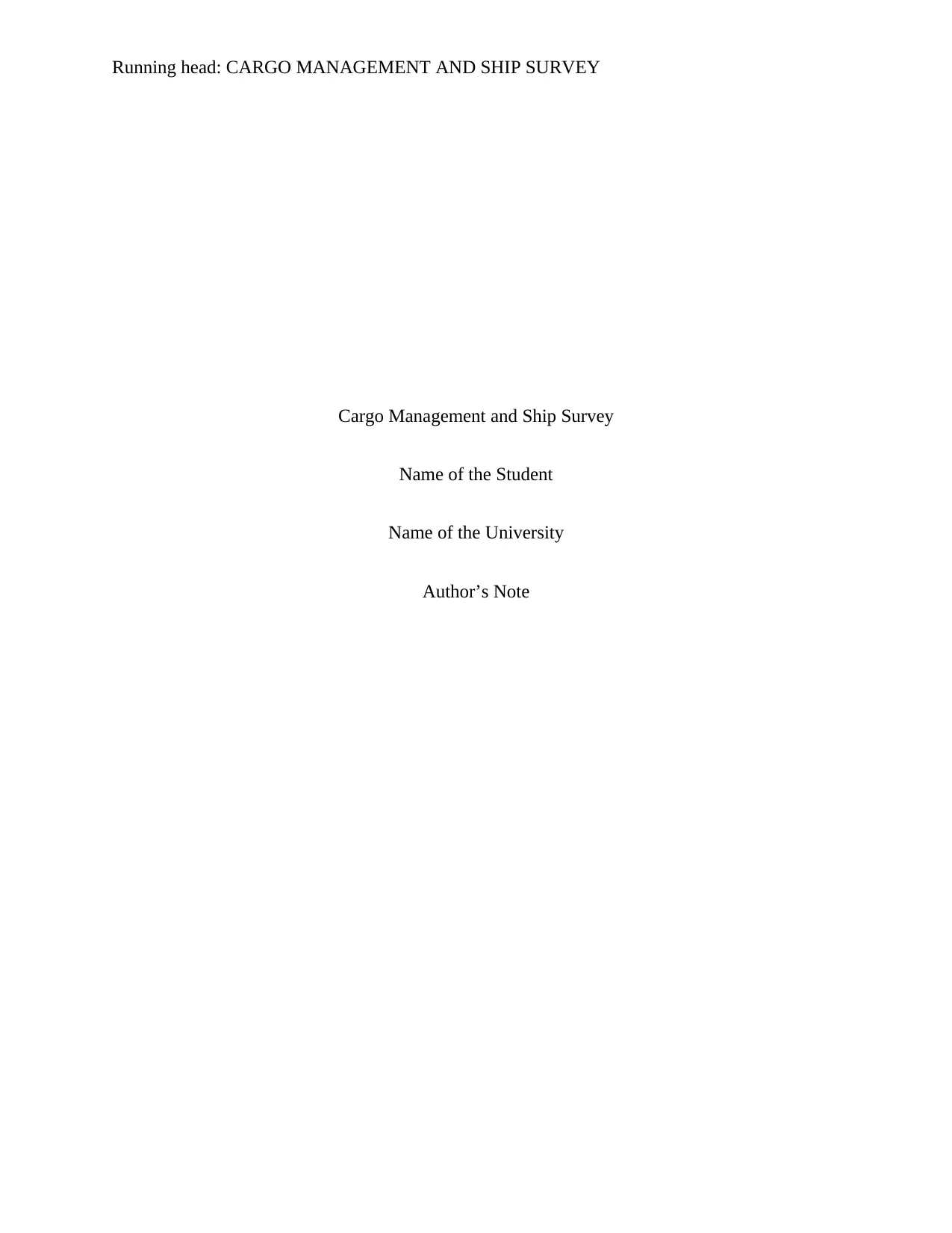
Running head: CARGO MANAGEMENT AND SHIP SURVEY
Cargo Management and Ship Survey
Name of the Student
Name of the University
Author’s Note
Cargo Management and Ship Survey
Name of the Student
Name of the University
Author’s Note
Paraphrase This Document
Need a fresh take? Get an instant paraphrase of this document with our AI Paraphraser
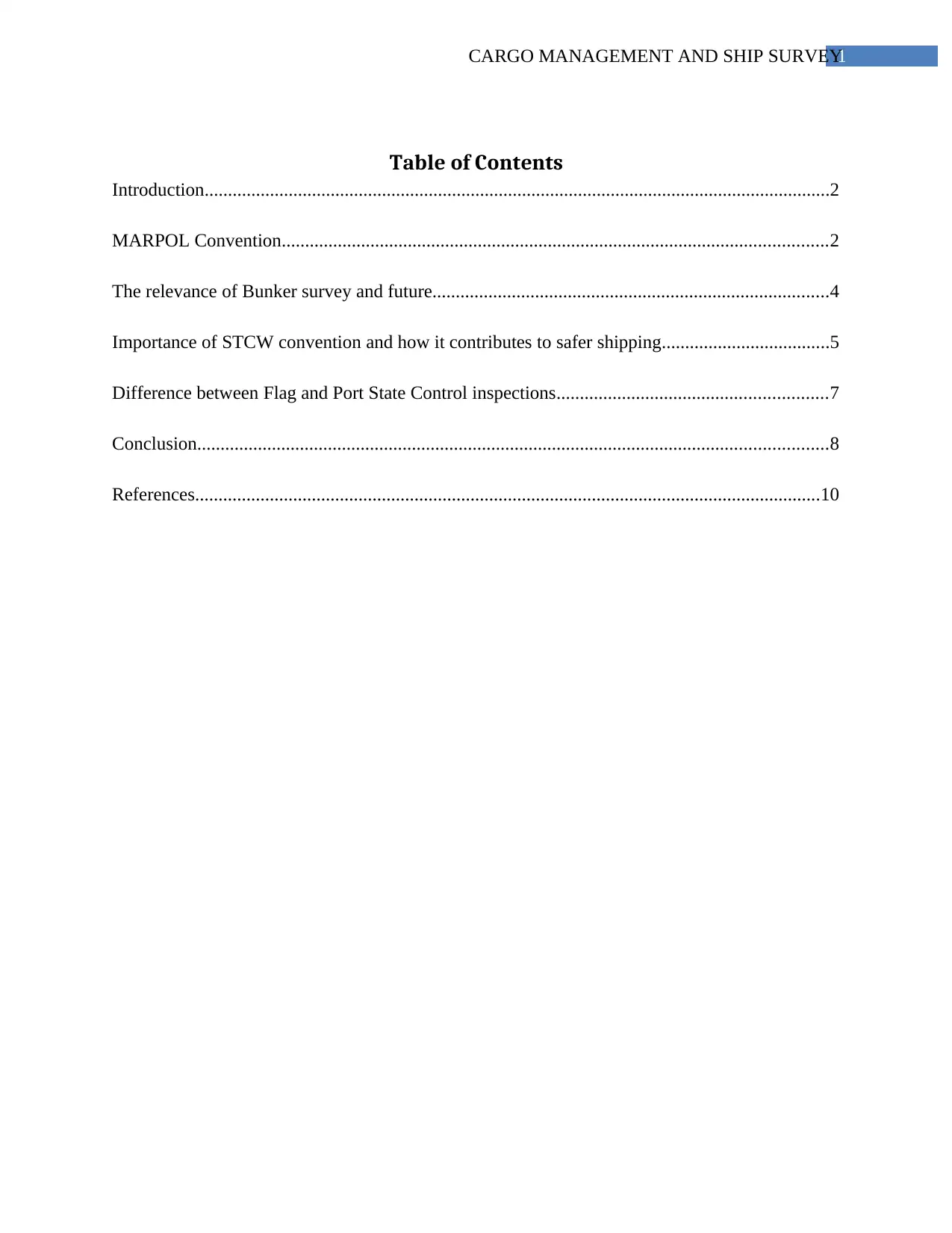
1CARGO MANAGEMENT AND SHIP SURVEY
Table of Contents
Introduction......................................................................................................................................2
MARPOL Convention.....................................................................................................................2
The relevance of Bunker survey and future.....................................................................................4
Importance of STCW convention and how it contributes to safer shipping....................................5
Difference between Flag and Port State Control inspections..........................................................7
Conclusion.......................................................................................................................................8
References......................................................................................................................................10
Table of Contents
Introduction......................................................................................................................................2
MARPOL Convention.....................................................................................................................2
The relevance of Bunker survey and future.....................................................................................4
Importance of STCW convention and how it contributes to safer shipping....................................5
Difference between Flag and Port State Control inspections..........................................................7
Conclusion.......................................................................................................................................8
References......................................................................................................................................10
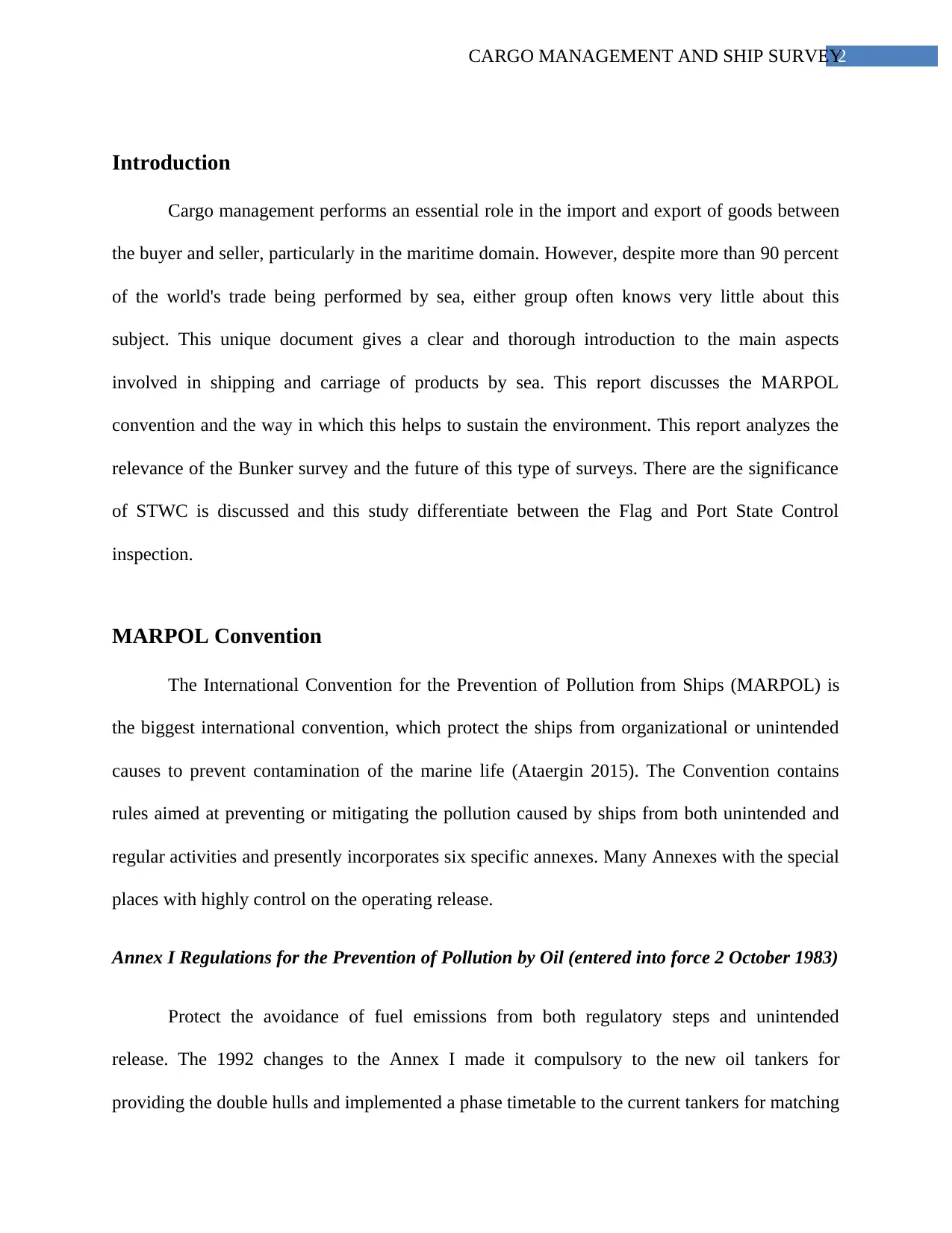
2CARGO MANAGEMENT AND SHIP SURVEY
Introduction
Cargo management performs an essential role in the import and export of goods between
the buyer and seller, particularly in the maritime domain. However, despite more than 90 percent
of the world's trade being performed by sea, either group often knows very little about this
subject. This unique document gives a clear and thorough introduction to the main aspects
involved in shipping and carriage of products by sea. This report discusses the MARPOL
convention and the way in which this helps to sustain the environment. This report analyzes the
relevance of the Bunker survey and the future of this type of surveys. There are the significance
of STWC is discussed and this study differentiate between the Flag and Port State Control
inspection.
MARPOL Convention
The International Convention for the Prevention of Pollution from Ships (MARPOL) is
the biggest international convention, which protect the ships from organizational or unintended
causes to prevent contamination of the marine life (Ataergin 2015). The Convention contains
rules aimed at preventing or mitigating the pollution caused by ships from both unintended and
regular activities and presently incorporates six specific annexes. Many Annexes with the special
places with highly control on the operating release.
Annex I Regulations for the Prevention of Pollution by Oil (entered into force 2 October 1983)
Protect the avoidance of fuel emissions from both regulatory steps and unintended
release. The 1992 changes to the Annex I made it compulsory to the new oil tankers for
providing the double hulls and implemented a phase timetable to the current tankers for matching
Introduction
Cargo management performs an essential role in the import and export of goods between
the buyer and seller, particularly in the maritime domain. However, despite more than 90 percent
of the world's trade being performed by sea, either group often knows very little about this
subject. This unique document gives a clear and thorough introduction to the main aspects
involved in shipping and carriage of products by sea. This report discusses the MARPOL
convention and the way in which this helps to sustain the environment. This report analyzes the
relevance of the Bunker survey and the future of this type of surveys. There are the significance
of STWC is discussed and this study differentiate between the Flag and Port State Control
inspection.
MARPOL Convention
The International Convention for the Prevention of Pollution from Ships (MARPOL) is
the biggest international convention, which protect the ships from organizational or unintended
causes to prevent contamination of the marine life (Ataergin 2015). The Convention contains
rules aimed at preventing or mitigating the pollution caused by ships from both unintended and
regular activities and presently incorporates six specific annexes. Many Annexes with the special
places with highly control on the operating release.
Annex I Regulations for the Prevention of Pollution by Oil (entered into force 2 October 1983)
Protect the avoidance of fuel emissions from both regulatory steps and unintended
release. The 1992 changes to the Annex I made it compulsory to the new oil tankers for
providing the double hulls and implemented a phase timetable to the current tankers for matching
⊘ This is a preview!⊘
Do you want full access?
Subscribe today to unlock all pages.

Trusted by 1+ million students worldwide
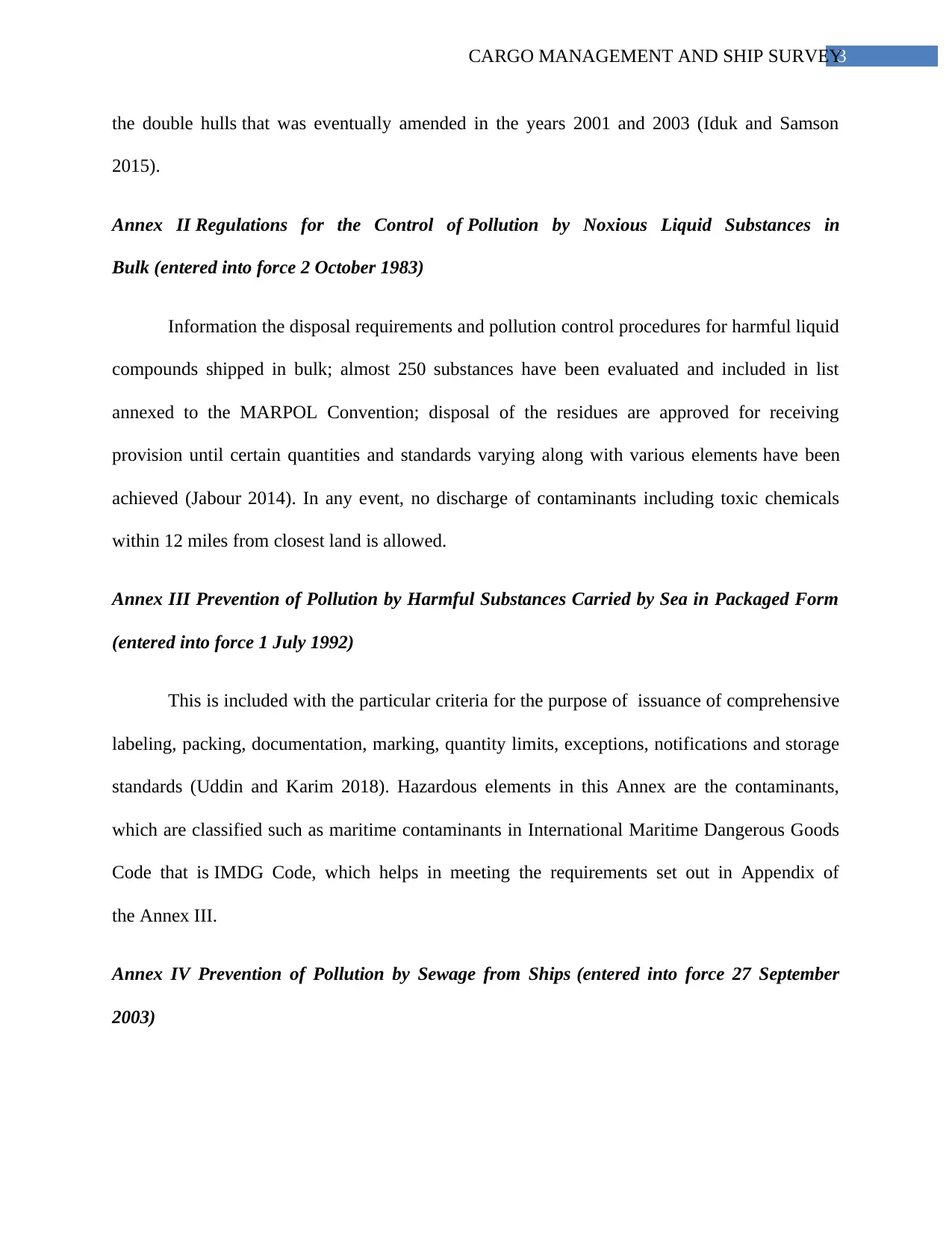
3CARGO MANAGEMENT AND SHIP SURVEY
the double hulls that was eventually amended in the years 2001 and 2003 (Iduk and Samson
2015).
Annex II Regulations for the Control of Pollution by Noxious Liquid Substances in
Bulk (entered into force 2 October 1983)
Information the disposal requirements and pollution control procedures for harmful liquid
compounds shipped in bulk; almost 250 substances have been evaluated and included in list
annexed to the MARPOL Convention; disposal of the residues are approved for receiving
provision until certain quantities and standards varying along with various elements have been
achieved (Jabour 2014). In any event, no discharge of contaminants including toxic chemicals
within 12 miles from closest land is allowed.
Annex III Prevention of Pollution by Harmful Substances Carried by Sea in Packaged Form
(entered into force 1 July 1992)
This is included with the particular criteria for the purpose of issuance of comprehensive
labeling, packing, documentation, marking, quantity limits, exceptions, notifications and storage
standards (Uddin and Karim 2018). Hazardous elements in this Annex are the contaminants,
which are classified such as maritime contaminants in International Maritime Dangerous Goods
Code that is IMDG Code, which helps in meeting the requirements set out in Appendix of
the Annex III.
Annex IV Prevention of Pollution by Sewage from Ships (entered into force 27 September
2003)
the double hulls that was eventually amended in the years 2001 and 2003 (Iduk and Samson
2015).
Annex II Regulations for the Control of Pollution by Noxious Liquid Substances in
Bulk (entered into force 2 October 1983)
Information the disposal requirements and pollution control procedures for harmful liquid
compounds shipped in bulk; almost 250 substances have been evaluated and included in list
annexed to the MARPOL Convention; disposal of the residues are approved for receiving
provision until certain quantities and standards varying along with various elements have been
achieved (Jabour 2014). In any event, no discharge of contaminants including toxic chemicals
within 12 miles from closest land is allowed.
Annex III Prevention of Pollution by Harmful Substances Carried by Sea in Packaged Form
(entered into force 1 July 1992)
This is included with the particular criteria for the purpose of issuance of comprehensive
labeling, packing, documentation, marking, quantity limits, exceptions, notifications and storage
standards (Uddin and Karim 2018). Hazardous elements in this Annex are the contaminants,
which are classified such as maritime contaminants in International Maritime Dangerous Goods
Code that is IMDG Code, which helps in meeting the requirements set out in Appendix of
the Annex III.
Annex IV Prevention of Pollution by Sewage from Ships (entered into force 27 September
2003)
Paraphrase This Document
Need a fresh take? Get an instant paraphrase of this document with our AI Paraphraser

4CARGO MANAGEMENT AND SHIP SURVEY
The criteria for the management of water waste by sewage; dumping of sewage in to the
water is banned, without when the ship has the authorized wastewater plant for treatment in
the service and when the ship releases disinfected or the comminuted sewage using
the authorized facility at the distance more than three maritime miles away. This should be from
the close land that must be released from the close land at a maximum of more than twelve miles
from the coast (Koboević and Milošević-Pujo 2018).
Annex V Prevention of Pollution by Garbage from Ships (entered into force 31 December
1988)
Deals for various waste types, which describes the lengths from the ground and how they
can be discarded of; the vital characteristic of this Annex is the total ban on the dumping of all
sorts of contaminants into the sea (Iduk and Samson 2015).
Annex VI Prevention of Air Pollution from Ships (entered into force 19 May 2005)
This sets restrictions on ship exhaust’s emissions of sulphur oxide and nitrogen oxide and
bans active pollution of the ozone depleting chemicals; established emission control areas have
stricter standards for NOx, SOx and particulate pollution (Koboević and Milošević-Pujo 2018).
A clause introduced in 2011 deals with compulsory technological and operating energy
efficiency steps designed to reduce ship’s greenhouse gas emissions.
The relevance of Bunker survey and future
The amount of bunker and lube petroleum onboard the ship is determined by a bunker
survey. Such surveys are the vital measure of the loss-prevention since it requires documentation
of the bunker operations in case of any claim or dispute (Karanassos 2015). In the case of a
The criteria for the management of water waste by sewage; dumping of sewage in to the
water is banned, without when the ship has the authorized wastewater plant for treatment in
the service and when the ship releases disinfected or the comminuted sewage using
the authorized facility at the distance more than three maritime miles away. This should be from
the close land that must be released from the close land at a maximum of more than twelve miles
from the coast (Koboević and Milošević-Pujo 2018).
Annex V Prevention of Pollution by Garbage from Ships (entered into force 31 December
1988)
Deals for various waste types, which describes the lengths from the ground and how they
can be discarded of; the vital characteristic of this Annex is the total ban on the dumping of all
sorts of contaminants into the sea (Iduk and Samson 2015).
Annex VI Prevention of Air Pollution from Ships (entered into force 19 May 2005)
This sets restrictions on ship exhaust’s emissions of sulphur oxide and nitrogen oxide and
bans active pollution of the ozone depleting chemicals; established emission control areas have
stricter standards for NOx, SOx and particulate pollution (Koboević and Milošević-Pujo 2018).
A clause introduced in 2011 deals with compulsory technological and operating energy
efficiency steps designed to reduce ship’s greenhouse gas emissions.
The relevance of Bunker survey and future
The amount of bunker and lube petroleum onboard the ship is determined by a bunker
survey. Such surveys are the vital measure of the loss-prevention since it requires documentation
of the bunker operations in case of any claim or dispute (Karanassos 2015). In the case of a
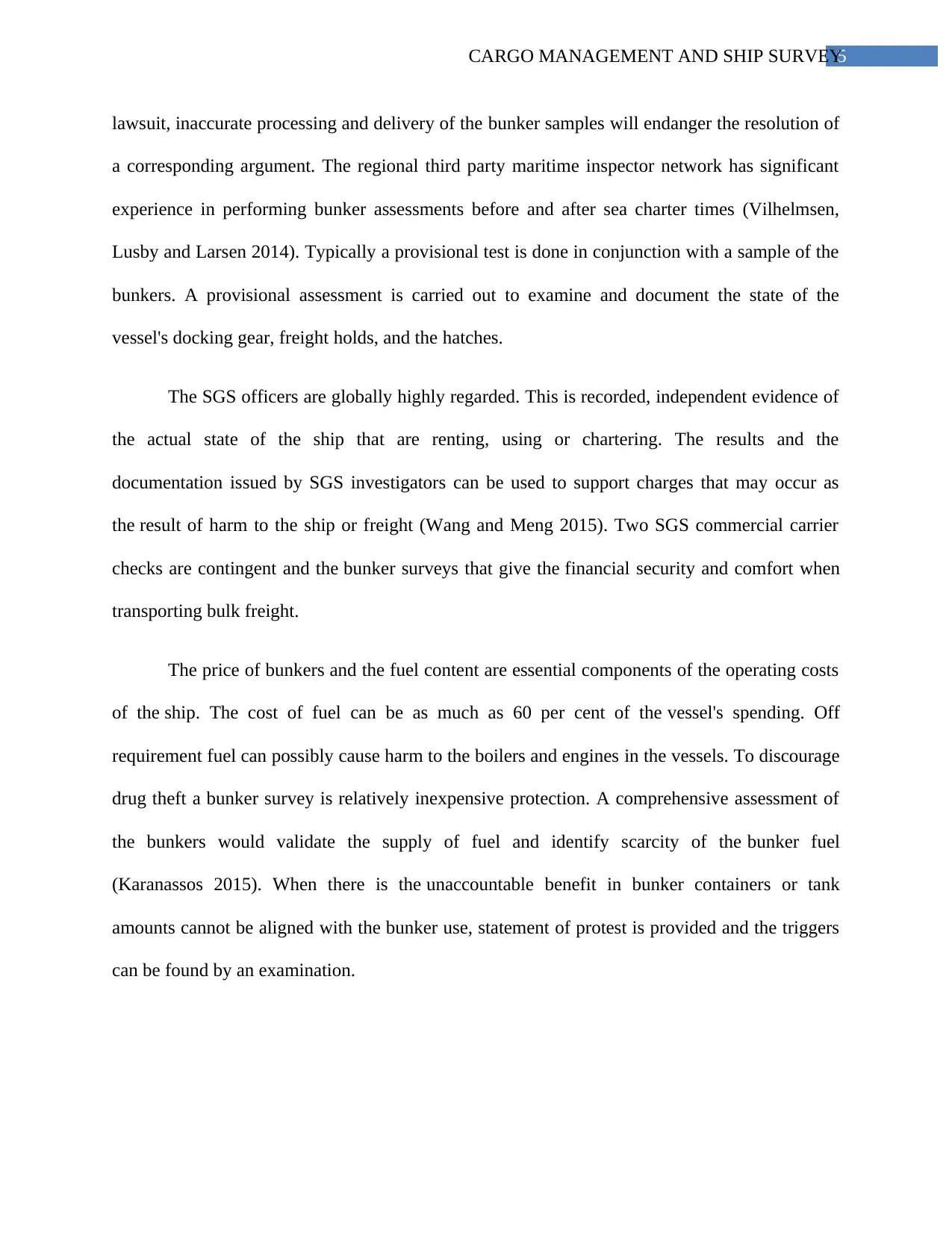
5CARGO MANAGEMENT AND SHIP SURVEY
lawsuit, inaccurate processing and delivery of the bunker samples will endanger the resolution of
a corresponding argument. The regional third party maritime inspector network has significant
experience in performing bunker assessments before and after sea charter times (Vilhelmsen,
Lusby and Larsen 2014). Typically a provisional test is done in conjunction with a sample of the
bunkers. A provisional assessment is carried out to examine and document the state of the
vessel's docking gear, freight holds, and the hatches.
The SGS officers are globally highly regarded. This is recorded, independent evidence of
the actual state of the ship that are renting, using or chartering. The results and the
documentation issued by SGS investigators can be used to support charges that may occur as
the result of harm to the ship or freight (Wang and Meng 2015). Two SGS commercial carrier
checks are contingent and the bunker surveys that give the financial security and comfort when
transporting bulk freight.
The price of bunkers and the fuel content are essential components of the operating costs
of the ship. The cost of fuel can be as much as 60 per cent of the vessel's spending. Off
requirement fuel can possibly cause harm to the boilers and engines in the vessels. To discourage
drug theft a bunker survey is relatively inexpensive protection. A comprehensive assessment of
the bunkers would validate the supply of fuel and identify scarcity of the bunker fuel
(Karanassos 2015). When there is the unaccountable benefit in bunker containers or tank
amounts cannot be aligned with the bunker use, statement of protest is provided and the triggers
can be found by an examination.
lawsuit, inaccurate processing and delivery of the bunker samples will endanger the resolution of
a corresponding argument. The regional third party maritime inspector network has significant
experience in performing bunker assessments before and after sea charter times (Vilhelmsen,
Lusby and Larsen 2014). Typically a provisional test is done in conjunction with a sample of the
bunkers. A provisional assessment is carried out to examine and document the state of the
vessel's docking gear, freight holds, and the hatches.
The SGS officers are globally highly regarded. This is recorded, independent evidence of
the actual state of the ship that are renting, using or chartering. The results and the
documentation issued by SGS investigators can be used to support charges that may occur as
the result of harm to the ship or freight (Wang and Meng 2015). Two SGS commercial carrier
checks are contingent and the bunker surveys that give the financial security and comfort when
transporting bulk freight.
The price of bunkers and the fuel content are essential components of the operating costs
of the ship. The cost of fuel can be as much as 60 per cent of the vessel's spending. Off
requirement fuel can possibly cause harm to the boilers and engines in the vessels. To discourage
drug theft a bunker survey is relatively inexpensive protection. A comprehensive assessment of
the bunkers would validate the supply of fuel and identify scarcity of the bunker fuel
(Karanassos 2015). When there is the unaccountable benefit in bunker containers or tank
amounts cannot be aligned with the bunker use, statement of protest is provided and the triggers
can be found by an examination.
⊘ This is a preview!⊘
Do you want full access?
Subscribe today to unlock all pages.

Trusted by 1+ million students worldwide
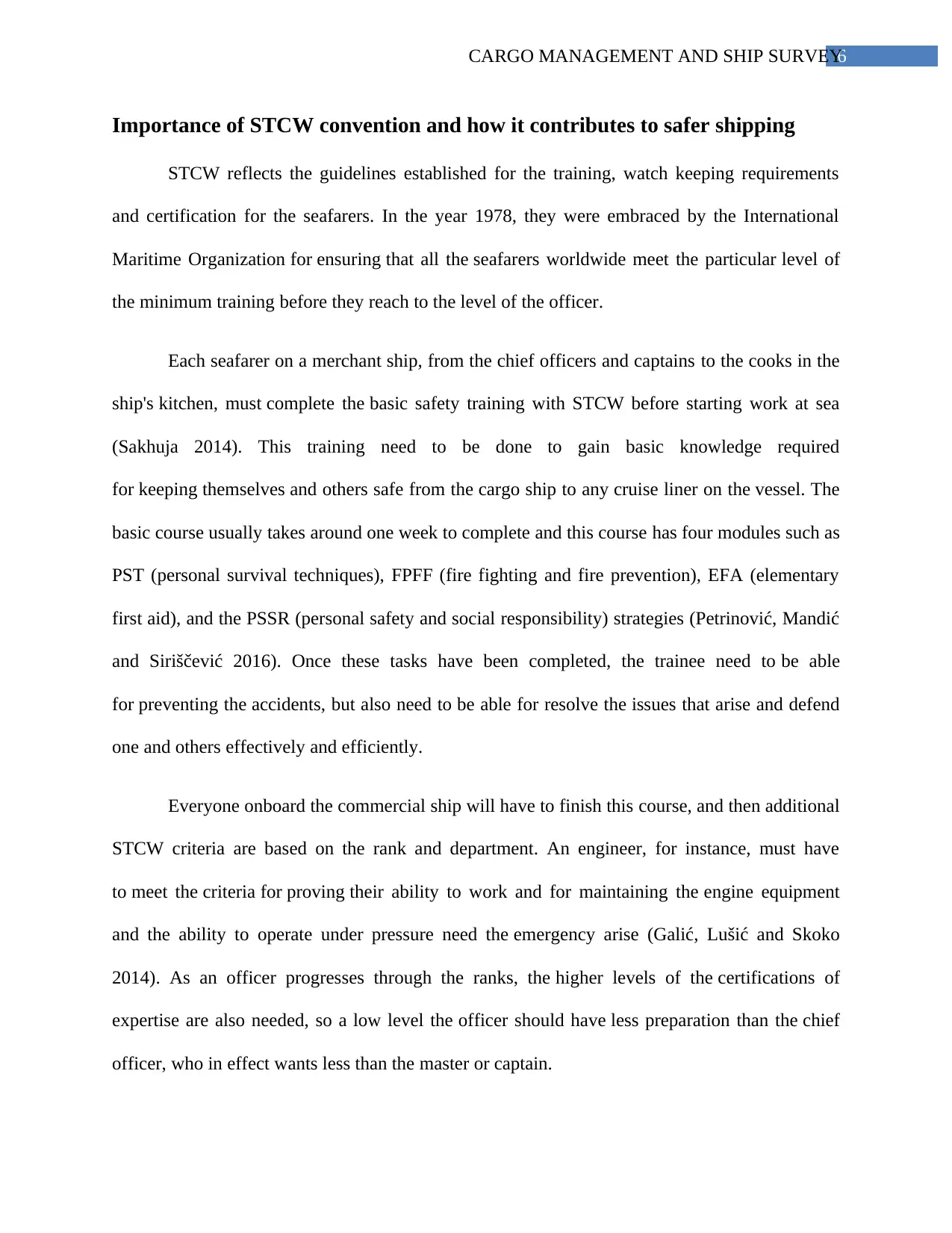
6CARGO MANAGEMENT AND SHIP SURVEY
Importance of STCW convention and how it contributes to safer shipping
STCW reflects the guidelines established for the training, watch keeping requirements
and certification for the seafarers. In the year 1978, they were embraced by the International
Maritime Organization for ensuring that all the seafarers worldwide meet the particular level of
the minimum training before they reach to the level of the officer.
Each seafarer on a merchant ship, from the chief officers and captains to the cooks in the
ship's kitchen, must complete the basic safety training with STCW before starting work at sea
(Sakhuja 2014). This training need to be done to gain basic knowledge required
for keeping themselves and others safe from the cargo ship to any cruise liner on the vessel. The
basic course usually takes around one week to complete and this course has four modules such as
PST (personal survival techniques), FPFF (fire fighting and fire prevention), EFA (elementary
first aid), and the PSSR (personal safety and social responsibility) strategies (Petrinović, Mandić
and Siriščević 2016). Once these tasks have been completed, the trainee need to be able
for preventing the accidents, but also need to be able for resolve the issues that arise and defend
one and others effectively and efficiently.
Everyone onboard the commercial ship will have to finish this course, and then additional
STCW criteria are based on the rank and department. An engineer, for instance, must have
to meet the criteria for proving their ability to work and for maintaining the engine equipment
and the ability to operate under pressure need the emergency arise (Galić, Lušić and Skoko
2014). As an officer progresses through the ranks, the higher levels of the certifications of
expertise are also needed, so a low level the officer should have less preparation than the chief
officer, who in effect wants less than the master or captain.
Importance of STCW convention and how it contributes to safer shipping
STCW reflects the guidelines established for the training, watch keeping requirements
and certification for the seafarers. In the year 1978, they were embraced by the International
Maritime Organization for ensuring that all the seafarers worldwide meet the particular level of
the minimum training before they reach to the level of the officer.
Each seafarer on a merchant ship, from the chief officers and captains to the cooks in the
ship's kitchen, must complete the basic safety training with STCW before starting work at sea
(Sakhuja 2014). This training need to be done to gain basic knowledge required
for keeping themselves and others safe from the cargo ship to any cruise liner on the vessel. The
basic course usually takes around one week to complete and this course has four modules such as
PST (personal survival techniques), FPFF (fire fighting and fire prevention), EFA (elementary
first aid), and the PSSR (personal safety and social responsibility) strategies (Petrinović, Mandić
and Siriščević 2016). Once these tasks have been completed, the trainee need to be able
for preventing the accidents, but also need to be able for resolve the issues that arise and defend
one and others effectively and efficiently.
Everyone onboard the commercial ship will have to finish this course, and then additional
STCW criteria are based on the rank and department. An engineer, for instance, must have
to meet the criteria for proving their ability to work and for maintaining the engine equipment
and the ability to operate under pressure need the emergency arise (Galić, Lušić and Skoko
2014). As an officer progresses through the ranks, the higher levels of the certifications of
expertise are also needed, so a low level the officer should have less preparation than the chief
officer, who in effect wants less than the master or captain.
Paraphrase This Document
Need a fresh take? Get an instant paraphrase of this document with our AI Paraphraser
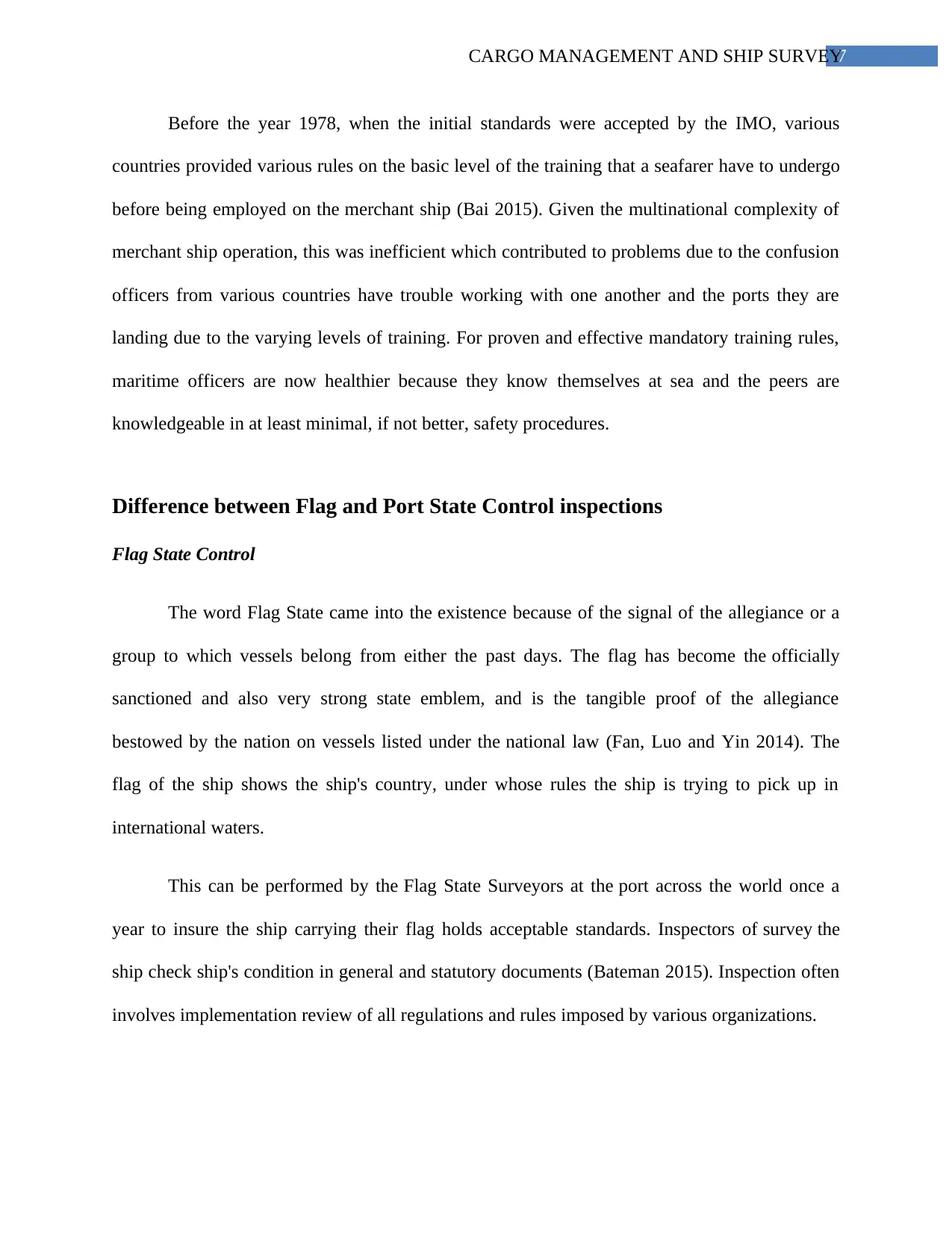
7CARGO MANAGEMENT AND SHIP SURVEY
Before the year 1978, when the initial standards were accepted by the IMO, various
countries provided various rules on the basic level of the training that a seafarer have to undergo
before being employed on the merchant ship (Bai 2015). Given the multinational complexity of
merchant ship operation, this was inefficient which contributed to problems due to the confusion
officers from various countries have trouble working with one another and the ports they are
landing due to the varying levels of training. For proven and effective mandatory training rules,
maritime officers are now healthier because they know themselves at sea and the peers are
knowledgeable in at least minimal, if not better, safety procedures.
Difference between Flag and Port State Control inspections
Flag State Control
The word Flag State came into the existence because of the signal of the allegiance or a
group to which vessels belong from either the past days. The flag has become the officially
sanctioned and also very strong state emblem, and is the tangible proof of the allegiance
bestowed by the nation on vessels listed under the national law (Fan, Luo and Yin 2014). The
flag of the ship shows the ship's country, under whose rules the ship is trying to pick up in
international waters.
This can be performed by the Flag State Surveyors at the port across the world once a
year to insure the ship carrying their flag holds acceptable standards. Inspectors of survey the
ship check ship's condition in general and statutory documents (Bateman 2015). Inspection often
involves implementation review of all regulations and rules imposed by various organizations.
Before the year 1978, when the initial standards were accepted by the IMO, various
countries provided various rules on the basic level of the training that a seafarer have to undergo
before being employed on the merchant ship (Bai 2015). Given the multinational complexity of
merchant ship operation, this was inefficient which contributed to problems due to the confusion
officers from various countries have trouble working with one another and the ports they are
landing due to the varying levels of training. For proven and effective mandatory training rules,
maritime officers are now healthier because they know themselves at sea and the peers are
knowledgeable in at least minimal, if not better, safety procedures.
Difference between Flag and Port State Control inspections
Flag State Control
The word Flag State came into the existence because of the signal of the allegiance or a
group to which vessels belong from either the past days. The flag has become the officially
sanctioned and also very strong state emblem, and is the tangible proof of the allegiance
bestowed by the nation on vessels listed under the national law (Fan, Luo and Yin 2014). The
flag of the ship shows the ship's country, under whose rules the ship is trying to pick up in
international waters.
This can be performed by the Flag State Surveyors at the port across the world once a
year to insure the ship carrying their flag holds acceptable standards. Inspectors of survey the
ship check ship's condition in general and statutory documents (Bateman 2015). Inspection often
involves implementation review of all regulations and rules imposed by various organizations.
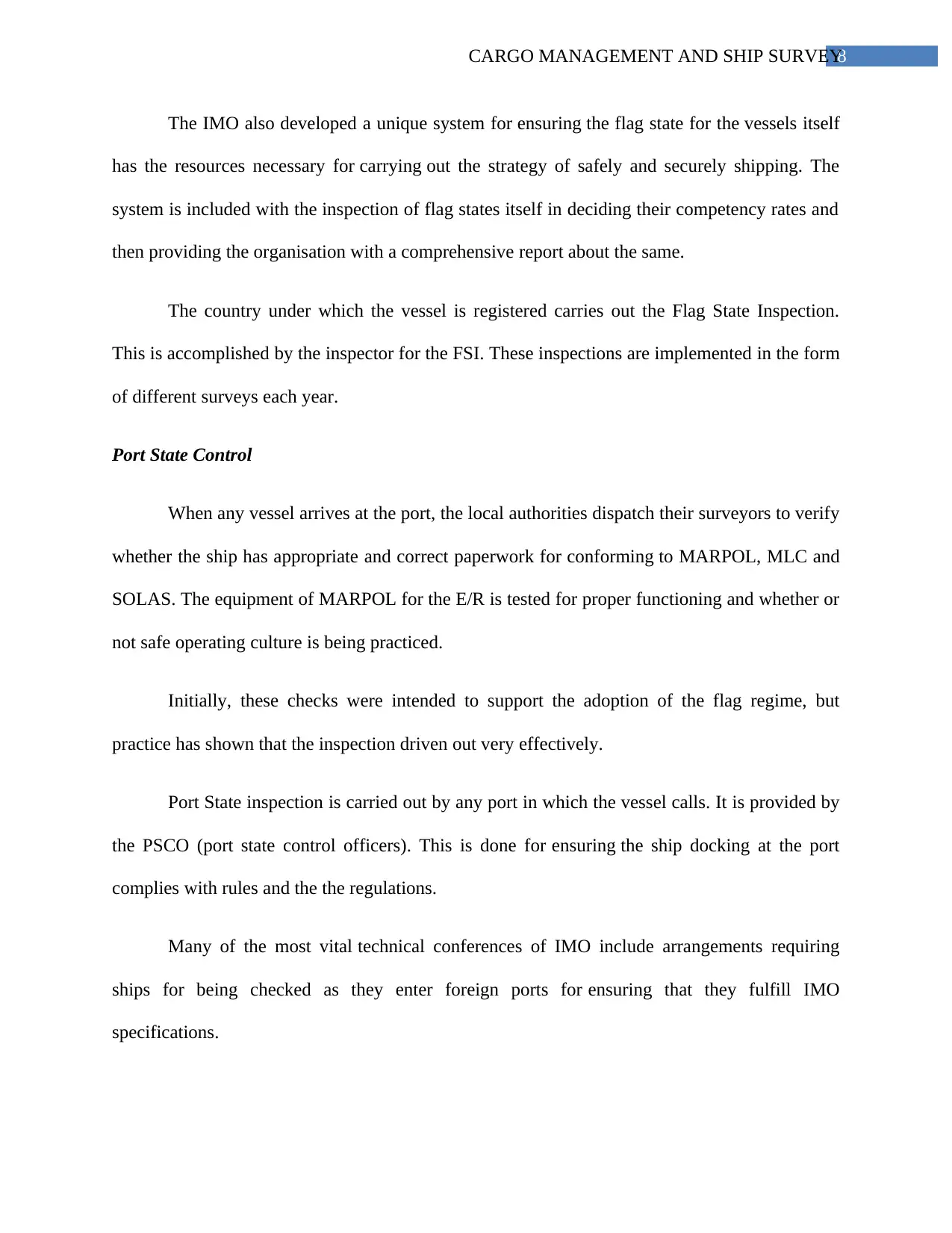
8CARGO MANAGEMENT AND SHIP SURVEY
The IMO also developed a unique system for ensuring the flag state for the vessels itself
has the resources necessary for carrying out the strategy of safely and securely shipping. The
system is included with the inspection of flag states itself in deciding their competency rates and
then providing the organisation with a comprehensive report about the same.
The country under which the vessel is registered carries out the Flag State Inspection.
This is accomplished by the inspector for the FSI. These inspections are implemented in the form
of different surveys each year.
Port State Control
When any vessel arrives at the port, the local authorities dispatch their surveyors to verify
whether the ship has appropriate and correct paperwork for conforming to MARPOL, MLC and
SOLAS. The equipment of MARPOL for the E/R is tested for proper functioning and whether or
not safe operating culture is being practiced.
Initially, these checks were intended to support the adoption of the flag regime, but
practice has shown that the inspection driven out very effectively.
Port State inspection is carried out by any port in which the vessel calls. It is provided by
the PSCO (port state control officers). This is done for ensuring the ship docking at the port
complies with rules and the the regulations.
Many of the most vital technical conferences of IMO include arrangements requiring
ships for being checked as they enter foreign ports for ensuring that they fulfill IMO
specifications.
The IMO also developed a unique system for ensuring the flag state for the vessels itself
has the resources necessary for carrying out the strategy of safely and securely shipping. The
system is included with the inspection of flag states itself in deciding their competency rates and
then providing the organisation with a comprehensive report about the same.
The country under which the vessel is registered carries out the Flag State Inspection.
This is accomplished by the inspector for the FSI. These inspections are implemented in the form
of different surveys each year.
Port State Control
When any vessel arrives at the port, the local authorities dispatch their surveyors to verify
whether the ship has appropriate and correct paperwork for conforming to MARPOL, MLC and
SOLAS. The equipment of MARPOL for the E/R is tested for proper functioning and whether or
not safe operating culture is being practiced.
Initially, these checks were intended to support the adoption of the flag regime, but
practice has shown that the inspection driven out very effectively.
Port State inspection is carried out by any port in which the vessel calls. It is provided by
the PSCO (port state control officers). This is done for ensuring the ship docking at the port
complies with rules and the the regulations.
Many of the most vital technical conferences of IMO include arrangements requiring
ships for being checked as they enter foreign ports for ensuring that they fulfill IMO
specifications.
⊘ This is a preview!⊘
Do you want full access?
Subscribe today to unlock all pages.

Trusted by 1+ million students worldwide

9CARGO MANAGEMENT AND SHIP SURVEY
A more comprehensive port state examination will be conducted whenever there is strong
reason to believe, during the inspection (Hänninen and Kujala 2014), that the state of the vessel
or of its machinery or personnel does not adequately satisfy the specific specifications of a
particular instrument. Valid reasons arise when the Port State Control Officer considers facts
warranting a more thorough examination of the cargo, its machinery or its personnel in his or her
professional judgment.
Conclusion
From this study, this can be concluded that the unique document of cargo management
and ship survey gives a clear and thorough introduction to the main aspects involved in shipping
and carriage of products by sea. The Convention contains the rules aimed at preventing or
mitigating the pollution caused by ships from both unintended and regular activities and doing
the STCW training, the seafarers can get the knowledge about the safety on ship. This report also
provides the understanding of the both Flag State Control and Port State Control and how these
inspection influence the seafarers and the environment by preventing the pollution utilizing the
MARPOL convention.
A more comprehensive port state examination will be conducted whenever there is strong
reason to believe, during the inspection (Hänninen and Kujala 2014), that the state of the vessel
or of its machinery or personnel does not adequately satisfy the specific specifications of a
particular instrument. Valid reasons arise when the Port State Control Officer considers facts
warranting a more thorough examination of the cargo, its machinery or its personnel in his or her
professional judgment.
Conclusion
From this study, this can be concluded that the unique document of cargo management
and ship survey gives a clear and thorough introduction to the main aspects involved in shipping
and carriage of products by sea. The Convention contains the rules aimed at preventing or
mitigating the pollution caused by ships from both unintended and regular activities and doing
the STCW training, the seafarers can get the knowledge about the safety on ship. This report also
provides the understanding of the both Flag State Control and Port State Control and how these
inspection influence the seafarers and the environment by preventing the pollution utilizing the
MARPOL convention.
Paraphrase This Document
Need a fresh take? Get an instant paraphrase of this document with our AI Paraphraser
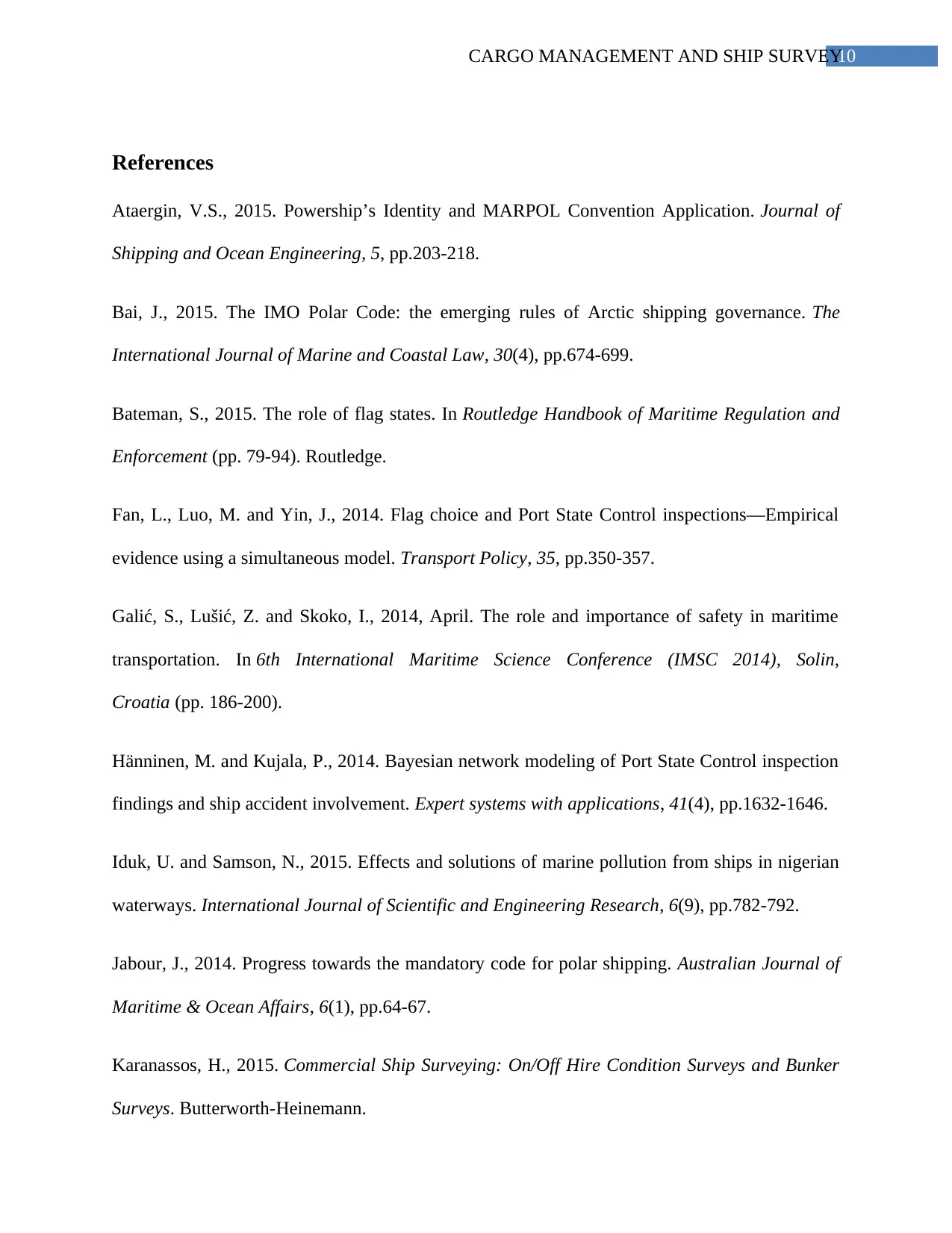
10CARGO MANAGEMENT AND SHIP SURVEY
References
Ataergin, V.S., 2015. Powership’s Identity and MARPOL Convention Application. Journal of
Shipping and Ocean Engineering, 5, pp.203-218.
Bai, J., 2015. The IMO Polar Code: the emerging rules of Arctic shipping governance. The
International Journal of Marine and Coastal Law, 30(4), pp.674-699.
Bateman, S., 2015. The role of flag states. In Routledge Handbook of Maritime Regulation and
Enforcement (pp. 79-94). Routledge.
Fan, L., Luo, M. and Yin, J., 2014. Flag choice and Port State Control inspections—Empirical
evidence using a simultaneous model. Transport Policy, 35, pp.350-357.
Galić, S., Lušić, Z. and Skoko, I., 2014, April. The role and importance of safety in maritime
transportation. In 6th International Maritime Science Conference (IMSC 2014), Solin,
Croatia (pp. 186-200).
Hänninen, M. and Kujala, P., 2014. Bayesian network modeling of Port State Control inspection
findings and ship accident involvement. Expert systems with applications, 41(4), pp.1632-1646.
Iduk, U. and Samson, N., 2015. Effects and solutions of marine pollution from ships in nigerian
waterways. International Journal of Scientific and Engineering Research, 6(9), pp.782-792.
Jabour, J., 2014. Progress towards the mandatory code for polar shipping. Australian Journal of
Maritime & Ocean Affairs, 6(1), pp.64-67.
Karanassos, H., 2015. Commercial Ship Surveying: On/Off Hire Condition Surveys and Bunker
Surveys. Butterworth-Heinemann.
References
Ataergin, V.S., 2015. Powership’s Identity and MARPOL Convention Application. Journal of
Shipping and Ocean Engineering, 5, pp.203-218.
Bai, J., 2015. The IMO Polar Code: the emerging rules of Arctic shipping governance. The
International Journal of Marine and Coastal Law, 30(4), pp.674-699.
Bateman, S., 2015. The role of flag states. In Routledge Handbook of Maritime Regulation and
Enforcement (pp. 79-94). Routledge.
Fan, L., Luo, M. and Yin, J., 2014. Flag choice and Port State Control inspections—Empirical
evidence using a simultaneous model. Transport Policy, 35, pp.350-357.
Galić, S., Lušić, Z. and Skoko, I., 2014, April. The role and importance of safety in maritime
transportation. In 6th International Maritime Science Conference (IMSC 2014), Solin,
Croatia (pp. 186-200).
Hänninen, M. and Kujala, P., 2014. Bayesian network modeling of Port State Control inspection
findings and ship accident involvement. Expert systems with applications, 41(4), pp.1632-1646.
Iduk, U. and Samson, N., 2015. Effects and solutions of marine pollution from ships in nigerian
waterways. International Journal of Scientific and Engineering Research, 6(9), pp.782-792.
Jabour, J., 2014. Progress towards the mandatory code for polar shipping. Australian Journal of
Maritime & Ocean Affairs, 6(1), pp.64-67.
Karanassos, H., 2015. Commercial Ship Surveying: On/Off Hire Condition Surveys and Bunker
Surveys. Butterworth-Heinemann.
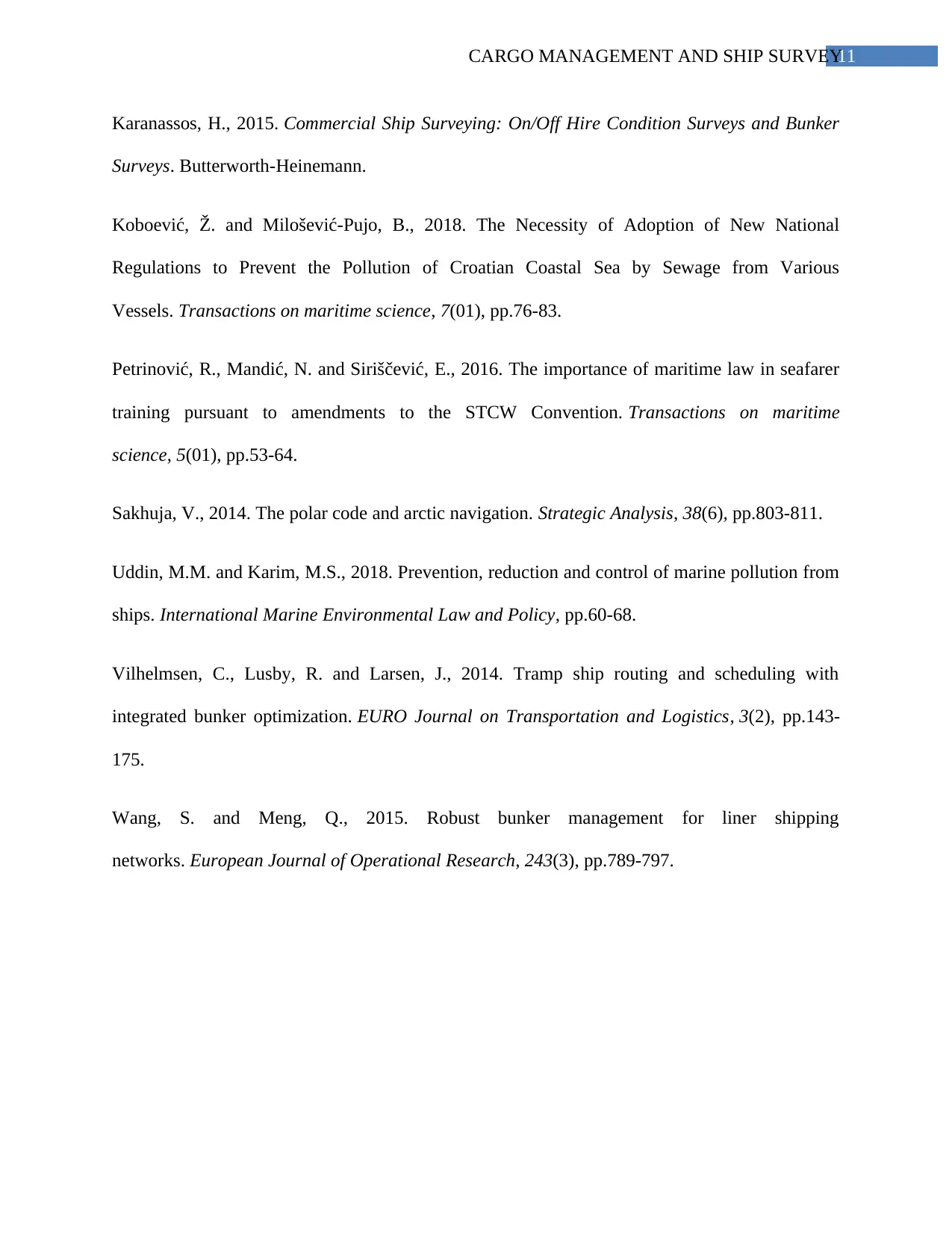
11CARGO MANAGEMENT AND SHIP SURVEY
Karanassos, H., 2015. Commercial Ship Surveying: On/Off Hire Condition Surveys and Bunker
Surveys. Butterworth-Heinemann.
Koboević, Ž. and Milošević-Pujo, B., 2018. The Necessity of Adoption of New National
Regulations to Prevent the Pollution of Croatian Coastal Sea by Sewage from Various
Vessels. Transactions on maritime science, 7(01), pp.76-83.
Petrinović, R., Mandić, N. and Siriščević, E., 2016. The importance of maritime law in seafarer
training pursuant to amendments to the STCW Convention. Transactions on maritime
science, 5(01), pp.53-64.
Sakhuja, V., 2014. The polar code and arctic navigation. Strategic Analysis, 38(6), pp.803-811.
Uddin, M.M. and Karim, M.S., 2018. Prevention, reduction and control of marine pollution from
ships. International Marine Environmental Law and Policy, pp.60-68.
Vilhelmsen, C., Lusby, R. and Larsen, J., 2014. Tramp ship routing and scheduling with
integrated bunker optimization. EURO Journal on Transportation and Logistics, 3(2), pp.143-
175.
Wang, S. and Meng, Q., 2015. Robust bunker management for liner shipping
networks. European Journal of Operational Research, 243(3), pp.789-797.
Karanassos, H., 2015. Commercial Ship Surveying: On/Off Hire Condition Surveys and Bunker
Surveys. Butterworth-Heinemann.
Koboević, Ž. and Milošević-Pujo, B., 2018. The Necessity of Adoption of New National
Regulations to Prevent the Pollution of Croatian Coastal Sea by Sewage from Various
Vessels. Transactions on maritime science, 7(01), pp.76-83.
Petrinović, R., Mandić, N. and Siriščević, E., 2016. The importance of maritime law in seafarer
training pursuant to amendments to the STCW Convention. Transactions on maritime
science, 5(01), pp.53-64.
Sakhuja, V., 2014. The polar code and arctic navigation. Strategic Analysis, 38(6), pp.803-811.
Uddin, M.M. and Karim, M.S., 2018. Prevention, reduction and control of marine pollution from
ships. International Marine Environmental Law and Policy, pp.60-68.
Vilhelmsen, C., Lusby, R. and Larsen, J., 2014. Tramp ship routing and scheduling with
integrated bunker optimization. EURO Journal on Transportation and Logistics, 3(2), pp.143-
175.
Wang, S. and Meng, Q., 2015. Robust bunker management for liner shipping
networks. European Journal of Operational Research, 243(3), pp.789-797.
⊘ This is a preview!⊘
Do you want full access?
Subscribe today to unlock all pages.

Trusted by 1+ million students worldwide
1 out of 12
Your All-in-One AI-Powered Toolkit for Academic Success.
+13062052269
info@desklib.com
Available 24*7 on WhatsApp / Email
![[object Object]](/_next/static/media/star-bottom.7253800d.svg)
Unlock your academic potential
© 2024 | Zucol Services PVT LTD | All rights reserved.

